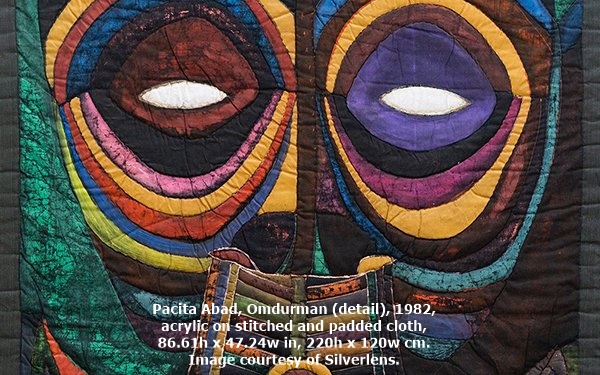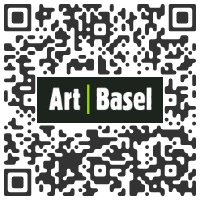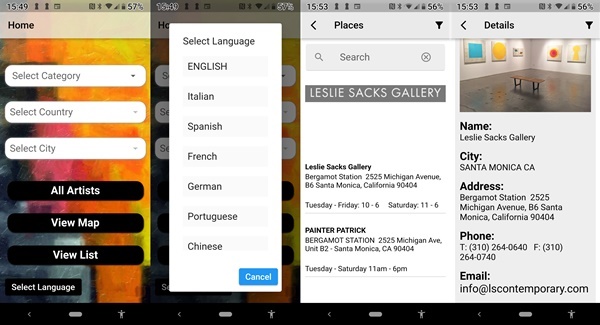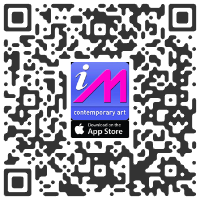"Masks and Spirits"
Pacita Abad

Silverlens Galleries
2263 Don Chino Roces Avenue Extension, Makati City 1231, PhilippinesT +63 2 8816 0044 F +63 2 8816 0044 M +63917 587 4011 e-mail:



Art Basel 2020
Messe Basel Messeplatz 10 4005 Basel Switzerland+41 79 739 35 38 e-mail:
October 28 > 31, 2020

SILVERLENS is thrilled to announce its participation in the Art Basel Online Viewing Room: 20c with a solo exhibition by the late
Filipino-American artist, Pacita Abad. This digital presentation, which lifts its title from Abad’s celebrated series, will feature five
vibrant large-scale trapunto paintings from 1982 through 2000, and will be simultaneously installed physically within the gallery’s
space. Despite previously exhibiting Abad’s pieces in Art Basel Hong Kong and Frieze London, this show marks the first time the
late artist’s works will be displayed in Silverlens. As one of the few galleries from Asia to be included in Online Viewing Room: 20c,
we feel immensely privileged to showcase a landmark series from Abad’s prolific career. We graciously extend an invitation to
the public, on the anniversary of Abad’s birth month, for this special homecoming presentation.
Pacita Abad was the living embodiment of a global spirit. In her fifty-eight years, she resided in five different continents and worked in over eighty countries. Consequently, her artistic practice was greatly informed by her extensive travels. Countless diverse experiences furnished Abad with a plethora of ideas, techniques, and materials – all of which she shrewdly incorporated into her art. It was during her time in Africa in the late 1970s that prompted her to begin painting Masks and Spirits, a monumental series in her artistic career. It was here where she began to experiment with the medium that came to identify her practice, trapunto paintings. Inspired by tribal masks from the world’s most remote areas, Abad created over fifty of these large, hand-stitched, colourfully embellished trapunto works in her lifetime. This series was a turning point in Abad’s artistic approach: not only did the scale of her works change, her aesthetic style likewise shifted from figurative realism to mystical abstract figuration.
Representative of her cross-cultural practice, Masks and Spirits embodies the values Abad held as an artist; they reflect socio- political commentaries while vividly celebrating tribal customs. An internationally prominent series, seven of these trapunto paintings currently hang in the eleventh edition of the Berlin Biennale; three are in the collection of the Tate London, and are scheduled to exhibit at the Tate Liverpool next month. In the last few decades, these works have travelled the globe extensively; we are fortunate to now share in the tremendous honour of hosting them in our gallery.
Pacita Abad (b. 1946, Batanes, Philippines; d. 2004, Singapore) was the daughter of a congressman, who had hoped that she would traverse a similar political path. But the course of Abad’s life changed when she decided to take up painting, after a year of travelling in Iran, Afghanistan, Pakistan, India, Sri Lanka, Myanmar, Thailand, Laos, Taiwan, and Hong Kong in 1973. Abad later married a developmental economist, Jack Garrity, whose work predisposed them to travel to developing countries. Her experiences in these remote regions informed her subject matter and aesthetic practice: she learned traditional art techniques from in each of the places she visited and incorporated these methods into her art. In the late seventies and early eighties Abad introduced a quilting method onto her canvasses, which she called trapunto. Here, she layered various objects — stones, sequins, glass, buttons, shells, mirrors, printed textile — atop the surfaces of these paintings, before stuffing and stitching them.
Characterised by vibrant colour and accumulated material, these large scale trapunto paintings traverse a diversity of subject matter: from tribal masks and social realist tableaus, to lush and intricately constructed underwater compositions and abstractions. She lived and travelled in numerous countries – from Bangladesh to Sudan, Sudan to Jakarta, Jakarta to Boston, Washington D.C. to Manila – and it was this itineracy that defined and shaped Abad’s cross-cultural practice. Abad’s work work brought together images and experiences across cultures, economies and histories. Her pieces offered global reflections long before the discourses of globalisation and transnationalism were felt in the art world.
Abad’s work has been featured in solo exhibitions at the National Museum, Jakarta, Indonesia; Hong Kong Arts Centre, Hong Kong, The Museum of Philippine Art, Manila; Cultural Center of the Philippines, Manila; Bhirasri Museum of Modern Art, Bangkok, Thailand; Singapore Tyler Print Institute, Singapore; The National Museum for Women in the Arts, Washington, D.C.; and the National Center of Afro-American Artists, Boston, among others. She has participated in numerous group exhibitions, including: Beyond the Border: Art by Recent Immigrants, Bronx Museum of the Arts, New York; Asia/ America: Identities in Contemporary Asian American Art, a traveling exhibition organized by the Asia Society, New York; Olympiad of Art, National Museum of Modern Art, Seoul, Korea; 2nd Asian Art Show, Fukuoka Art Museum, Fukuoka, Japan and La Bienal de Habana, Havana, Cuba. Abad died in Singapore in 2004.
Pacita Abad was the living embodiment of a global spirit. In her fifty-eight years, she resided in five different continents and worked in over eighty countries. Consequently, her artistic practice was greatly informed by her extensive travels. Countless diverse experiences furnished Abad with a plethora of ideas, techniques, and materials – all of which she shrewdly incorporated into her art. It was during her time in Africa in the late 1970s that prompted her to begin painting Masks and Spirits, a monumental series in her artistic career. It was here where she began to experiment with the medium that came to identify her practice, trapunto paintings. Inspired by tribal masks from the world’s most remote areas, Abad created over fifty of these large, hand-stitched, colourfully embellished trapunto works in her lifetime. This series was a turning point in Abad’s artistic approach: not only did the scale of her works change, her aesthetic style likewise shifted from figurative realism to mystical abstract figuration.
Representative of her cross-cultural practice, Masks and Spirits embodies the values Abad held as an artist; they reflect socio- political commentaries while vividly celebrating tribal customs. An internationally prominent series, seven of these trapunto paintings currently hang in the eleventh edition of the Berlin Biennale; three are in the collection of the Tate London, and are scheduled to exhibit at the Tate Liverpool next month. In the last few decades, these works have travelled the globe extensively; we are fortunate to now share in the tremendous honour of hosting them in our gallery.
Pacita Abad (b. 1946, Batanes, Philippines; d. 2004, Singapore) was the daughter of a congressman, who had hoped that she would traverse a similar political path. But the course of Abad’s life changed when she decided to take up painting, after a year of travelling in Iran, Afghanistan, Pakistan, India, Sri Lanka, Myanmar, Thailand, Laos, Taiwan, and Hong Kong in 1973. Abad later married a developmental economist, Jack Garrity, whose work predisposed them to travel to developing countries. Her experiences in these remote regions informed her subject matter and aesthetic practice: she learned traditional art techniques from in each of the places she visited and incorporated these methods into her art. In the late seventies and early eighties Abad introduced a quilting method onto her canvasses, which she called trapunto. Here, she layered various objects — stones, sequins, glass, buttons, shells, mirrors, printed textile — atop the surfaces of these paintings, before stuffing and stitching them.
Characterised by vibrant colour and accumulated material, these large scale trapunto paintings traverse a diversity of subject matter: from tribal masks and social realist tableaus, to lush and intricately constructed underwater compositions and abstractions. She lived and travelled in numerous countries – from Bangladesh to Sudan, Sudan to Jakarta, Jakarta to Boston, Washington D.C. to Manila – and it was this itineracy that defined and shaped Abad’s cross-cultural practice. Abad’s work work brought together images and experiences across cultures, economies and histories. Her pieces offered global reflections long before the discourses of globalisation and transnationalism were felt in the art world.
Abad’s work has been featured in solo exhibitions at the National Museum, Jakarta, Indonesia; Hong Kong Arts Centre, Hong Kong, The Museum of Philippine Art, Manila; Cultural Center of the Philippines, Manila; Bhirasri Museum of Modern Art, Bangkok, Thailand; Singapore Tyler Print Institute, Singapore; The National Museum for Women in the Arts, Washington, D.C.; and the National Center of Afro-American Artists, Boston, among others. She has participated in numerous group exhibitions, including: Beyond the Border: Art by Recent Immigrants, Bronx Museum of the Arts, New York; Asia/ America: Identities in Contemporary Asian American Art, a traveling exhibition organized by the Asia Society, New York; Olympiad of Art, National Museum of Modern Art, Seoul, Korea; 2nd Asian Art Show, Fukuoka Art Museum, Fukuoka, Japan and La Bienal de Habana, Havana, Cuba. Abad died in Singapore in 2004.
 |
Pacita Abad |
Online VIEWING ROOM
QR of this press release
in your phone, tablet








